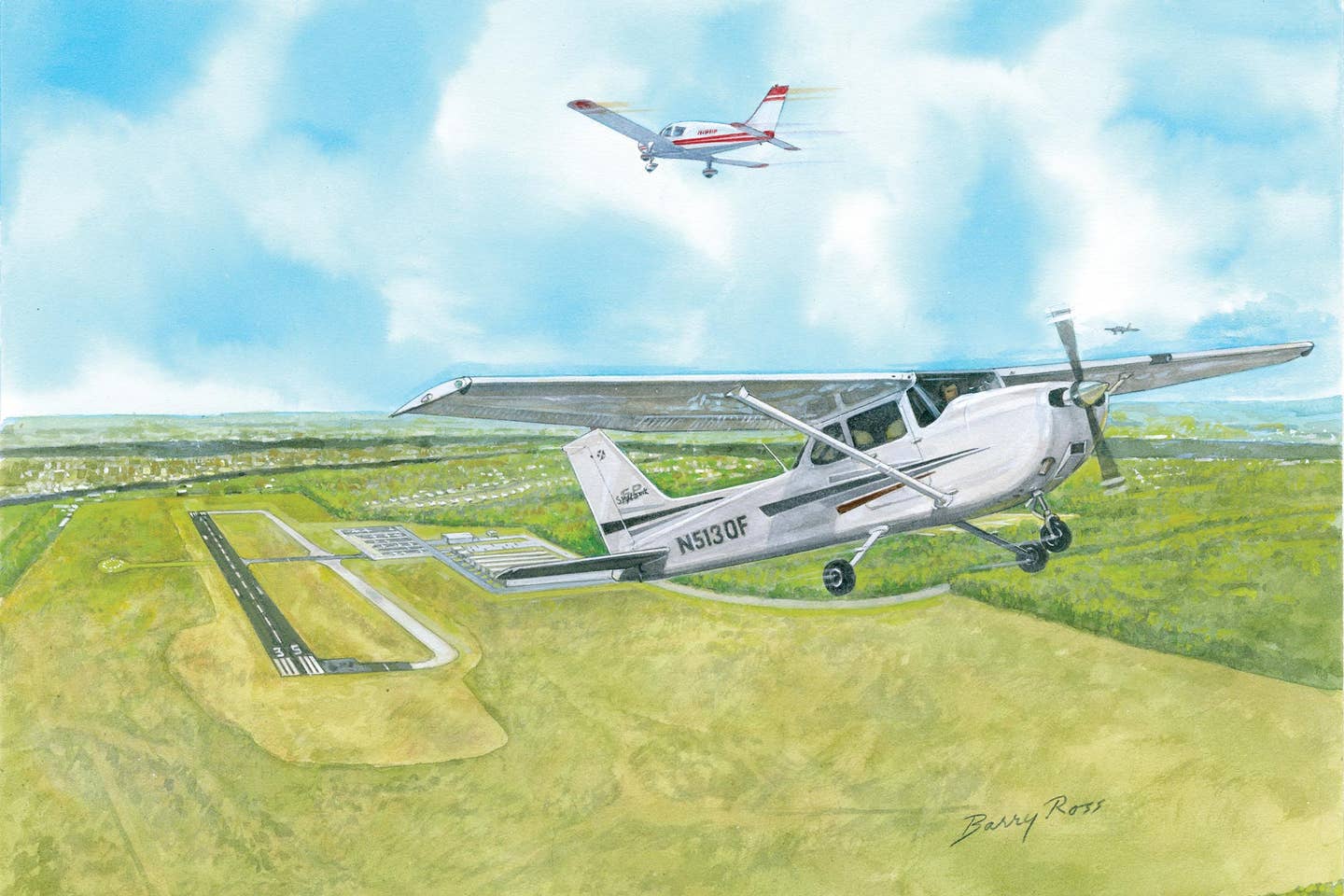
A busy, nontowered airport can feel to the uninitiated a little like the Wild West. Barry Ross
Pop quiz. You’re in the pattern at a nontowered airport on a calm day, announcing your turn to base for Runway 35, which is right traffic. Just then, you hear two other pilots make their first calls on the common traffic advisory frequency—one of them announcing they’re 2 miles out on a straight-in downwind for Runway 17, which is left traffic, while the other says they’re on a 4-mile base for 17.
Do you:
- Key the mic and calmly inform the pilots that FAR 91.113 dictates that you have the right of way?
- Ask in your best Chuck Yeager voice if either of them have heard you making pattern approach calls for 35 since you were 10 miles out?
- Say a very bad word, throttle up, and get the hell out of there?
If you’re me, you choose Option 3 after doing a little of Option 2, though not so much like Chuck Yeager as I might have wished. I probably sounded more like what I am: a VFR rookie pilot doing his best to handle a suddenly very tricky situation.
It’s a common refrain: Pilots who fly out of nontowered airports are nervous about talking to ATC, and pilots accustomed to flying in controlled airspace are anxious about flying into a nontowered field, where there’s no ATC to watch your six.
Also unlike controlled airspace, you’re not required to have a transponder or radio in Class G or E airspace, though flying without a transponder in Class E pretty much limits your travel to the aviation equivalent of your driveway. Even if you do have a radio, you’re not required to use it at a nontowered airport, just as long as you keep your eyes open and don’t hit anyone. The latter’s still against the rules.
So a busy, nontowered airport can feel to the uninitiated a little like the Wild West. I fly out of Mount Pleasant Regional (LRO), a Class G field 15 nautical miles northeast of Charleston, South Carolina, with 3,700 feet of asphalt on our single runway, 35/17. A subdivision immediately west of the field means 35 has mandatory right traffic—to keep the neighbors happy.
Charleston International (CHS) sits 13 nm to the west with just 3 nm between its Class C airspace border and LRO’s runway. Charleston Executive (JZI), a far busier Class G airport, with two Citation-friendly runways, lies 16 nm southwest of LRO, 12 nm south of CHS.
CHS also shares real estate with Joint Base Charleston, home of the United States Air Force 437th Airlift Wing. It’s not unusual to loiter outside LRO’s FBO and watch a massive C-17 Globemaster circling overhead as low as 2,000 feet. Add a Coast Guard air station dispatching Day-Glo orange helicopters to patrol the coast just 6 nm south of LRO, and you’d better be constantly scanning the skies. You’d also better be talking on, and listening to, that radio you’re not required to have.
Put simply: At nontowered airports, you and your fellow pilots function as ATC. But it’s all voluntary—it only works if we accept and share that responsibility.
There were a lot of things going on that day I ducked out of the pattern—and even more wrongdoing that carried us to that point.
First, the winds were calm. With AWOS providing no obvious choice, I asked unicom which runway was being favored during my first radio call, 10 miles out. Absent other traffic, “take your pick” was the answer. I chose 35 for ease of approach and announced as much.
I hadn’t heard a single call on the CTAF other than mine until I was a mile out on the pattern-entry 45. That’s when our first friend made his initial broadcast, a mere 3 miles out to the south, also asking what runway was being favored. Unicom didn’t answer, so I announced I was just then turning downwind, right traffic for 35.
The other pilot didn’t reply. I assumed he’d heard and so understood that my position ahead of him on approach meant 35 was the active runway. My mistake, as I would soon discover.
I’d just throttled back abeam the numbers and dropped my first notch of flaps when our second friend made his first radio call, declaring he was on a 4-mile base for 17. Whether he was flying his novel approach at pattern altitude or descending to it, he didn’t say.
Read More: I Learned About Flying From That
That’s when Sky Captain No. 1 chimed in for only the second time, announcing his now 2-mile straight-in downwind for 17. So much for understanding the ramifications of my earlier call.
At this point, I was turning downwind to base. I announced my position, sounding only moderately irritated as I asked if either of my buddies had been monitoring the CTAF. That’s when No. 2 made his second call, declaring he was now on a 3-mile base for 17. I suppose he thought he was being helpful.
Federal Aviation Regulations state I had the right of way—lowest altitude, closest proximity to the runway. But the only question that mattered is, could I have continued my approach and landed safely?
Honest answer? Maybe. Sure, I probably could have set down and cleared the active before either of our friends touched down and we kissed spinners. Assuming, that is, that the other position calls were accurate, and that I landed short enough to taxi off midfield and nothing occurred to force me to execute a go-around.
I wasn’t willing to stake my life on “maybe,” “probably” and “assuming.” I’d already muttered my bad word, pushed the throttle to the firewall and was banking south before I announced I was exiting the pattern, adding, “I’ll give y’all room to work things out.”
The penny finally dropped for my friends. They became suddenly very chatty, rapidly announcing their positions in turns like they were calling a horse race.
Having established positive rate of climb, I retracted flaps and declared my intention to circle south of the field at pattern altitude and then make left traffic for 17. Given my altitude on base, I was probably at around 800 msl by now, 20 seconds since my last call.
That’s when I looked up and saw pilot No. 1’s plane dart by directly overhead—from the southwest, with all of 400 lousy feet of vertical separation between us.
If he’d been on a true straight-in downwind, there would’ve been at least a half-mile horizontal separation between us. Instead, our vectors were converging at fewer than 45 degrees horizontally and even more shallow vertically. If he’d been another half-mile out: bang.
I enjoyed my leisurely southerly loop while my sky buddies landed and declared they were clear of the active. A few minutes later, I was on the ground too, and in one piece, which is always a bonus. By the time I’d killed the master switch on the ramp, the other pilots were gone.
In retrospect, I certainly should have followed up on my initial downwind radio call, confirming that Mr. Straight-In understood I was making right traffic for 35. Also, I’d exited the pattern to the south out of reflex; I could’ve instead made my go-around an extended westward base and avoided that close call on my climb out.
Even so, I was pleased at how I’d handled things and said a silent thank-you to my CFIs for hammering home conservative aeronautical decision-making. I don’t know if those other pilots realized their bad decisions, or ever will. But at least one of us knuckleheads up there had—and that was all it took to help keep all three of us safe.
This story appeared in the March 2020 issue of Flying Magazine

Sign-up for newsletters & special offers!
Get the latest FLYING stories & special offers delivered directly to your inbox






